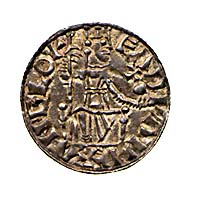April 3, 1043: Edward the Confessor consecrated king at Winchester
 |
| King Edward seated on a throne, facing right, holding a sceptre in one hand and a ball with cross on top in the other. Legend: EADPARD + ANGLOX [for ANGLORUM] |
It was probably to shore up Harthacnut's unpopular regime that another of his half-brothers, Edward the Confessor, who had been in exile in Normandy, was brought back in 1041, and sworn in as joint-king with Harthacnut. After Harthacnut died in 1042, Edward became sole king.
The Chronicle presents Edward's accession as inevitable ("the people chose Edward and received him as king, as was his natural right"), but this papers over deep divisions. We learn, not from English but from Norman sources, that Edward landed at Southampton with a fleet of forty ships in 1036, and was repelled, presumably by forces loyal to Harold or Harthacnut. (Edward's brother Alfred tried to come back in the same year, but fell afoul of Earl Godwine, who according to some accounts tortured and killed him.) It seems that Duke Robert of Normandy was plotting an invasion of England in support of Edward in the early 1030s, near the end of Cnut's reign. So it comes as no surprise that Edward's reign was a long struggle with the family of Godwine, and that he favoured his Norman friends more than the English liked. (After the events of the 1030s, Edward probably trusted the Normans a good deal more than he trusted the English.) Nor that when Edward died in 1066 and Harold Godwine's son succeeded, Duke Robert's son invaded from Normandy.
Review the history, 1033-66.